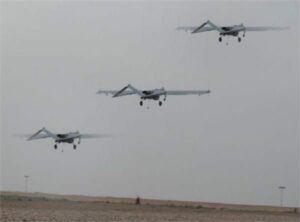 The US Army has announced that its Rapid Equipping Force (REF), on Fort Belvoir, Virginia, and Asymmetric Warfare Group (AWG), on Fort Meade, Maryland, have been partnering to prevent threats from the proliferation of small unmanned aerial systems, or UASs. The organizations aim to help units fill capability gaps in Afghanistan, South Korea and elsewhere.
The US Army has announced that its Rapid Equipping Force (REF), on Fort Belvoir, Virginia, and Asymmetric Warfare Group (AWG), on Fort Meade, Maryland, have been partnering to prevent threats from the proliferation of small unmanned aerial systems, or UASs. The organizations aim to help units fill capability gaps in Afghanistan, South Korea and elsewhere.
Thousands of small, low-tech drones are being launched worldwide by a growing number of nations and non-state actors who could challenge U.S. interests, said Col. Steven Sliwa, director of the REF.
“The enemy is using these small systems,” said Lt. Col. Stephen Lee, AWG Concepts Integration Squadron commander.
In Ukraine, Russian separatists are using quad copters and other small UAS primarily for intelligence, surveillance and reconnaissance, Lee said.
He worries though, that in the future these small unmanned aircraft could be armed and used for more than just reconnaissance. So AWG and REF teamed up to study the threat.
“We don’t want the United States Army ever to be caught by surprise again like we were with the IED,” Lee said last month at a Warriors Corner presentation during the Association of the United States Army’s annual meeting and exposition.
He explained how they first replicated the threat at AWG’s $90-million training and solution-development facility on Fort A.P. Hill, Virginia. The 300-acre facility has its own mosque, soccer stadium and subway station.
Multiple types of UAS were launched at the facility to disrupt friendly operations. Then AWG and REF went to work to figure out how the threat could be stopped. While REF focuses on new technology and material solutions, AWG looks at non-material solutions like tactics, techniques and procedures.
Lee said he believes old-fashioned training needs to be part of the solution.
“Really going back to pre-9/11 training,” he said, “air guards, graphical training aids, camouflage tents…” He said Soldiers need training to instill awareness of the aerial threat.
“We’ve had air dominance so long, Soldiers believe if it’s flying, it’s ours,” Lee said. That may not be the case in the future with UAS proliferation.
With thousands of small unmanned aircraft hovering about, technological solutions were also looked at to identify the UAS and potentially stop them.
REF looked at nine potential technologies to counter the UAS threat. A live-fire exercise was conducted at Yuma Proving Ground, Arizona, to test the technologies.
“We took a lot of these off-the-shelf hobby-shop, low-slow types of devices [and] went against an adversary,” Sliwa said. AWG operated as the red team.
Other agencies were invited to participate in the Yuma exercise, and some of them demonstrated their technologies, Sliwa said.
“Not all of them worked great, but all of them learned from that,” he said.
Results from the Yuma Proving Ground counter-UAS exercise should be available later this month, Sliwa said.
“We’re still waiting for final results, but we think that we have found some things that under certain circumstances may be able to work.”
The REF will look at the most promising technologies and platforms for further assessment, he said, and then equip solutions to the deployed force.
Commanders in the field are concerned about the UAS threat, he said. They could see it coming and so could other federal agencies. Earlier this year, a small drone evaded radars and came down on the White House South Lawn, causing consternation from the Secret Service.
“Even before the one landed on the White House lawn, AWG and REF were already collaborating on this threat,” Sliwa said.
REF has been collaborating with AWG more this year than before, and both are now under the U.S. Army Training and Doctrine Command, or TRADOC.


















